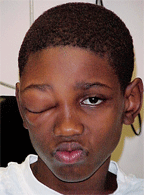 History
History
An 11-year-old black male presented for evaluation of a severely swollen right eye. The emergency department admitted the boy because his eyelid had been swelling continually during the previous three days. His eyelid was hot and tender to the touch, and he had a fever of 100.6°F. Other than what the patient described as a pimple on his upper eyelid for the past five days, his ocular and systemic histories were unremarkable. He reported no allergies and took no medications.
Diagnostic Data
His best-corrected visual acuity measured 20/30 O.U. at distance and near. He reported no additional pain upon motility testing, and no vision loss or diplopia. Intraocular pressure measured 25mm Hg O.D. and 14mm Hg O.S. The dilated fundus examination was normal O.U. The pertinent anterior segment findings are illustrated in the photograph.
 |
| This 11-year-old patient presented with a severely swollen
right eye and a fever of 100.6°F. What is the likely diagnosis?
|
How would you approach this case? Does this patient require any additional tests? What is your diagnosis? How would you manage this patient? What’s the likely prognosis?
Discussion
Additional testing included neuroimaging to rule out orbital, sinus and osseous involvement. The diagnosis in this issue is preseptal cellulitis. The major causes of both preseptal and orbital cellulitis are sinusitis (58%), lid or facial infection (28%), foreign body insult (11%) and hematogenous infiltration (4%).1-5 Staphylococcus and Streptococcus are the most common causes of preseptal cellulitis in adults, while Haemophilus influenzae, gram-negative bacilli, Pseudomonas, Escherichia coli and insect larvae are commonly implicated in children.3-5
Symptoms of preseptal cellulitis include pain, tenderness to the touch, lid edema and erythema, chemosis, and axial proptosis (if diffuse disease or orbital abscess exists).1,2 Decreased ocular motility and elevated IOP secondary to a swollen globe are common.5 Visual loss from optic nerve involvement, optic neuritis or vasculitis also may ensue. Finally, thrombosis, subdural empyema, and intracranial abscess may result from untreated, posterior extension into the cavernous sinus.1-5 Systemic symptoms of preseptal cellulitis include malaise and fever.1-5 Additionally, headache, nausea, vomiting and decreased consciousness are indicative of cavernous sinus involvement.1-5
The warning signs of developing orbital cellulitis include a dilated pupil, marked ophthalmoplegia, loss of vision, afferent pupillary defect, papilledema, perivasculitis and violaceous (“black and blue”) lids.5 Imaging is required in all suspected cases of preseptal and orbital cellulitis. Positive imaging results demonstrate diffuse orbital infiltrate with opacification of adjacent sinuses or bone.5
In children, treatment is initiated with aggressive systemic antibiotics (usually following hospital admission and IV administration); sinus drainage is not required in 50% of cases.1-5 In adults, the drainage of sinuses and abscesses may be required in up to in 90% of cases.5 The prognosis is often very good following prompt initiation of antibiotic therapy and surgical drainage (when indicated).1-5
We treated our patient with 500mg oral cephalosporin q.i.d. as well as hot compresses and topical bacitracin ointment. The presentation resolved during the next 10 days, without complication. Additionally, his IOP returned to normal levels (16mm Hg). We presume that his IOP was elevated at the time of the initial examination secondary to blepharospasm from pain as well as swelling.
1. Jaeger EA, Jeffers JB, Tipperman R, et al. Orbit and Orbital Disease. In: Rhee DJ, Pyfer MF. The Wills Eye Manual: Office and Emergency Room Diagnosis and Treatment of Eye Disease. Philadelphia: J.B. Lippincott Co., 1999:167-70.
2. Starkey CR, Steele RW. Medical management of orbital cellulitis. Pediatr Infect Dis J. 2001 Oct;20(10):1002-5.
3. Hytonen M, Atula T, Pitkaranta A. Complications of acute sinusitis in children. Acta Otolaryngol Suppl. 2000;543:154-7.
4. Jun BK, Shin JC, Woog JJ. Palpebral myiasis. Korean J Ophthalmol. 1999 Dec;13(2):138-40.
5. Dutton JJ. Orbital diseases. In: Yanoff M, Duker JS. Ophthalmology. Philadelphia: Mosby, 1999:14.1-8.

